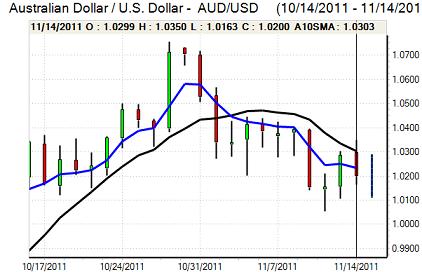EUR/USD
The Euro was unable to make any further attack on resistance towards 1.38 against the dollar on Monday and was subjected to substantial selling pressure during the day. The Italian government did secure a solid response in the latest bond auction, but there was still a sharp rise in yields compared with the previous sale. There were fresh doubts whether the new Italian government would be able to stabilise the economic situation as the optimism triggered by Berlusconi’s resignation faded quickly.
There was also a rise in Spanish yields during the day with benchmark 10-year yields rising to tough the 6.0% level for the first time since August which reinforced the contagion threat, especially with French yields also rising as markets again fretted over the AAA rating.
The new Greek government stated its determination to stay within the Euro area, but markets remained unconvinced, especially with the New Democracy party stating that there would be no support for further austerity measures. ECB head Weidmann again voiced his opposition to any deficit financing by the ECB and there was further evidence of internal splits. The German Finance Minister stated that there would be no move to bring the ESM forward to 2012 from 2013 and this will leave the burden on the under-financed EFSF. Confidence will weaken further if the latest GDP data is weaker than expected.
There were no major US data releases during the day and there was an increase in unease surrounding the budget situation as the Super Committee has not been able to produce a cohesive strategy to solve the severe structural budget deficit. A firm retail sales figure on Tuesday could boost sentiment towards the economy and would also tend to improve risk appetite.
The Euro-zone situation still tended to dominate and there as renewed defensive demand for US Treasuries as risk appetite dipped again. In this environment, the Euro lost support in the 1.3650 area and dipped to lows below 1.36. There has been a decline in net speculative long dollar positions which should increase the currency’s resilience.

Source: VantagePoint Intermarket Analysis Software
Call now and you will be provided with FREE recent forecasts
that are up to 86% accurate* 800-732-5407
If you would rather have the recent forecasts sent to you, please go here
Yen
The dollar was subjected to renewed selling pressure on Monday and dipped to lows near 76.80 after a break of support near 77 triggered stop-loss selling. The US currency did recover back to the 77 area with markets reluctant to maintain long yen positions given the threat of intervention.
The Japanese currency continued to gain defensive support from renewed doubts surrounding the Euro-zone and global economies. There will be a further reluctance to push funds out of Japan and there is also the additional threat of capital repatriation.
In this environment, heavy selling pressure on the yen remains unlikely with the dollar unable to make a sustain move much above 77.0 despite a spike to near 77.50.
Sterling
Sterling hit tough resistance close to 1.6080 against the US dollar on Monday and then fell sharply. Although to some extent this reflected wider dollar moves, sellers also took advantage of levels above the 1.60 area. There was a decline to lows below 1.5880 as support levels came under attack, but there was support close to 0.86 against the Euro.
There were expectations that the Bank of England would again downgrade its growth forecasts for the economy in Wednesday’s quarterly inflation report. There was also a suspicion that it would be difficult to attract further defensive funds into the UK from the Euro-zone given that yield differentials have already moved sharply against the UK currency. High volatility is likely to remain the key market feature in the short term.
Swiss franc
The dollar maintained a more resilient tone on Monday with strong support on dips to just below the 0.90 area and there was a push to high above 0.91 as the US currency gained wider support. The Euro was also broadly resilient and traded around 1.24 despite losses on the other major crosses.
This time, the Swiss currency was unable to derive any benefit from a deterioration in risk appetite. There was renewed speculation that the National Bank would raise the minimum Euro level and this continued to discourage any aggressive speculative flows into the Swiss currency.

Source: VantagePoint Intermarket Analysis Software
Call now and you will be provided with FREE recent forecasts
that are up to 86% accurate* 800-732-5407
If you would rather have the recent forecasts sent to you, please go here
Australian dollar
The Australian dollar was unable to make any fresh advance to above the 1.03 level against the US dollar on Monday and was subjected to renewed selling pressure during the day as risk conditions deteriorated with lows below 1.0180 during the US session.
There was a temporary recovery following the Reserve Bank minutes from November as the bank had considered leaving interest rates on hold, but the currency was unable to sustain the gains. There were further doubts surrounding the Euro-zone and global economies which undermined sentiment, especially as confidence in the Asian outlook also deteriorated.



